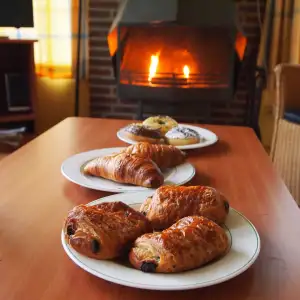Lefse: Unlock the Secrets of this Traditional Norwegian Flatbread for Unforgettable Food Experiences

Lefse is a beloved traditional Norwegian flatbread that has been enjoyed for generations. It is a staple in Norwegian cuisine and holds a special place in the hearts of many. This thin and soft bread is made from simple ingredients but packs a punch of flavor. Whether you are new to lefse or have been enjoying it for years, this article will unlock the secrets of this delicious flatbread and inspire you to incorporate it into your cooking repertoire. Get ready to elevate your culinary skills with the magic of lefse!
History and Origins of Lefse
Lefse, a traditional Norwegian flatbread, has a rich history that dates back centuries. Its origins can be traced to the Vikings, who used to cook bread on hot stones. Over time, this evolved into the lefse we know today.
Originally, lefse was made using leftover potatoes and flour, making it an economical and practical food. It was often prepared in large quantities during harvest season and stored for the long winter months.
In the past, lefse-making was a communal activity where families and neighbors would gather to roll out the dough and cook it on a griddle. It was a time of bonding and celebration, with each family having their own secret recipe passed down through generations.
Today, lefse remains deeply rooted in Norwegian culture and is enjoyed during special occasions such as Christmas and weddings. It has also gained popularity worldwide as people embrace its unique taste and cultural significance. The history of lefse is a testament to the enduring traditions that connect us to our past and bring joy to our present-day lives.
Ingredients Used in Lefse Making
When it comes to making lefse, the ingredients are simple yet essential. The main components of this traditional Norwegian flatbread include potatoes, flour, butter, salt, and sometimes sugar. Potatoes form the base of the dough, providing a soft and pliable texture. Flour is added to give structure and stability to the bread. Butter adds richness and flavor, while salt enhances the taste. Some recipes may call for a touch of sugar to balance out the flavors. These basic ingredients come together to create a versatile dough that can be rolled out thinly and cooked on a griddle or stovetop.
Step-by-Step Guide to Making Lefse
1. Start by boiling and mashing potatoes until smooth.
2. Add butter, cream, sugar, and salt to the mashed potatoes, mixing well.
3. Gradually add flour to the potato mixture until a soft dough forms.
4. Divide the dough into small balls and roll each ball into a thin circle on a floured surface.
5. Heat a griddle or large skillet over medium heat and lightly grease it with butter or oil.
6. Cook each lefse round on the griddle for about 1-2 minutes on each side until golden brown spots appear.
7. Remove from heat and stack the cooked lefse between clean kitchen towels to keep them soft and pliable.
8. Repeat the process with the remaining dough balls until all lefse are cooked.
9. Serve warm with butter, cinnamon sugar, or your favorite toppings.
Follow these simple steps to create delicious homemade lefse that will impress your family and friends with its authentic taste and texture!
Traditional Ways to Serve Lefse
Lefse is a versatile flatbread that can be enjoyed in various ways. One classic way to serve lefse is by spreading it with butter and sprinkling it with sugar. This simple combination brings out the delicate flavors of the bread and creates a sweet and savory treat.
Another traditional way to serve lefse is by filling it with savory ingredients such as mashed potatoes, bacon, or lutefisk (a traditional Norwegian dish made from dried whitefish). These fillings add depth and richness to the bread, creating a satisfying meal.
Lefse can also be rolled up with other ingredients like smoked salmon, cream cheese, and dill for a delicious Scandinavian-inspired wrap. This combination of flavors provides a refreshing and light option for those looking for a quick and easy meal.
In addition to these classic serving methods, lefse can also be used as a base for other dishes. It can be topped with various spreads like hummus or pesto, or used as a wrap for grilled vegetables or meats.
No matter how you choose to serve lefse, one thing is certain – it will always bring a taste of Norway to your table and leave you craving more of its unique flavors.
Variations and Modern Twists on Lefse Recipes
While traditional lefse recipes are delicious on their own, there are also plenty of variations and modern twists you can try to elevate this Norwegian flatbread even further. One popular variation is adding different flavors to the dough, such as herbs like dill or rosemary, or spices like cinnamon or cardamom for a sweet twist.
Another modern twist is using alternative flours in the dough, such as whole wheat or rye flour, to add a nuttier flavor and increase the nutritional value. You can also experiment with different fillings and toppings, such as smoked salmon and cream cheese, or caramelized apples with cinnamon sugar.
For those looking for a gluten-free option, there are now recipes available that use alternative flours like almond flour or potato starch. These variations still maintain the soft texture and delicate taste of traditional lefse while catering to dietary restrictions.
Additionally, some creative chefs have even used lefse as a base for unique dishes like lefse tacos or lefse wraps filled with savory ingredients like grilled vegetables or pulled pork.
Exploring these variations and modern twists on lefse recipes allows you to personalize this traditional Norwegian flatbread according to your taste preferences and culinary creativity. So don't be afraid to think outside the box and create your own unique lefse creations!
Tips and Tricks for Perfecting Your Lefse
1. Use the right potatoes: Choose starchy potatoes like Russets or Yukon Golds for the perfect texture and taste.
2. Keep your dough cool: Refrigerate the dough before rolling it out to prevent sticking and ensure a light, fluffy lefse.
3. Roll evenly: Use a lefse rolling pin with deep grooves to create an even thickness throughout the flatbread.
4. Dust with flour: Sprinkle flour on your work surface, rolling pin, and lefse to prevent sticking while rolling.
5. Flip carefully: When cooking on a griddle, flip the lefse gently using a long, thin spatula to avoid tearing.
6. Cook at the right temperature: Maintain a medium-high heat on your griddle to achieve a golden-brown color without burning.
7. Store properly: To keep your lefse fresh, store it in an airtight container or wrap it tightly in plastic wrap.
8. Experiment with flavors: Add spices like cinnamon or cardamom to your dough for unique flavor variations.
9. Practice makes perfect: Don't be discouraged if your first attempts aren't flawless – mastering lefse takes time and practice!
With these tips and tricks, you'll be well on your way to creating delicious and authentic lefse that will impress family and friends alike!
Health Benefits of Lefse
Lefse, the traditional Norwegian flatbread, not only delights the taste buds but also offers several health benefits. Made primarily from potatoes, lefse is a good source of complex carbohydrates, providing sustained energy and keeping you full for longer periods. It is low in fat and cholesterol, making it a healthier alternative to other bread options. Additionally, lefse contains essential vitamins and minerals like vitamin C and potassium. So, indulge in this delicious treat guilt-free and enjoy its nutritional advantages.
Lefse, with its rich history and versatile nature, is a culinary delight that should not be overlooked. Its soft texture and delicate flavor make it the perfect accompaniment to a variety of dishes. Whether you choose to serve it with savory fillings or sweet toppings, lefse is sure to elevate your cooking skills and impress your guests.
By mastering the art of lefse making, you can unlock the secrets of this traditional Norwegian flatbread and create unforgettable food experiences. The process may seem daunting at first, but with practice and patience, you will soon be able to roll out thin, perfectly cooked rounds of lefse.
Don't be afraid to experiment with different flavors and fillings. Traditional ways to serve lefse include spreading it with butter and sprinkling it with cinnamon sugar or filling it with savory ingredients like smoked salmon or mashed potatoes. However, there are also modern twists on lefse recipes that incorporate unique ingredients such as herbs, cheeses, or even chocolate.
In addition to its delicious taste, lefse also offers health benefits. Made primarily from potatoes, lefse is a good source of fiber and provides essential nutrients like vitamin C and potassium. It can be enjoyed as part of a balanced diet and can even be modified to suit dietary restrictions by using gluten-free flour or alternative ingredients.
So why not embrace the flavors of lefse in your cooking? Whether you're looking to impress your family at Sunday brunch or add a touch of Scandinavian charm to your next dinner party, lefse is sure to leave a lasting impression. So grab your rolling pin and get ready to embark on a culinary journey filled with tradition, creativity, and deliciousness!
Published: 02. 12. 2023
Category: Food



